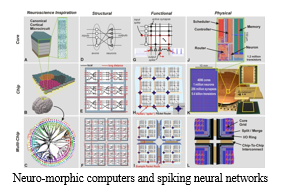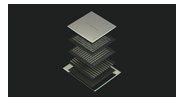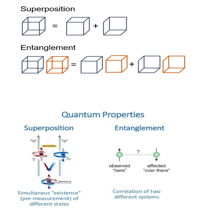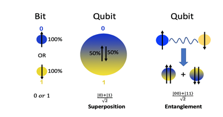Ijraset Journal For Research in Applied Science and Engineering Technology
- Home / Ijraset
- On This Page
- Abstract
- Introduction
- Conclusion
- References
- Copyright
An Essay on Quantum Processors
Authors: K. V. R . Pranav
DOI Link: https://doi.org/10.22214/ijraset.2022.46453
Certificate: View Certificate
Abstract
Fundamentally we need a processor to carryout computations and intelligent jobs. A CPU in a computer based on Intel technology has been common. As is time getting advanced researchers continued working on large problems for solutions with in minimum time. They expect quantum computers could give good answer in minimum time. This article tried to understand the quantum processors.
Introduction
I. INTRODUCTION
A processor in a computer is an integrated electronic circuit which performs the calculations. A processor performs arithmetical, logical, input/output (I/O) operations. Further a processor also has to perform basic instructions that are passed from an operating system (OS). Most of the intelligent processes are dependent on the operations of a processor.
The terms processor, central processing unit (CPU) and microprocessor are synonyms. Most people use the word “processor” interchangeably with the term “CPU” now a days. Technically CPU is just one of the processors inside a personal computer (PC)
A processor is also one which measures efficiency in terms of the ability to process instructions at a given time, and maximum number of bits/instructions used and clock speed.
Every time that an operation is preformed, the processor will have to interpret the operating system. The processing of operations can be faster or slower. This has a greater impact on the “processing speed” of the CPU.
Intelligent systems are technologically advanced machines that perceive and respond to the domain of the problem. Intelligent systems can take many forms
from automated vacuums to facial recognition programs.
A normal processor mainly is used in every personal computer. Fundamentally the central processing unit is described as a processor of the system. CPU is made of integrated chips to organize all the components at a single place. Different manufacturers provide different load based processors for computer systems and mobile systems. The processors are designed based on available versions and generations, namely Intel i5, AMD A8 etc.
An AI processor: Processors used in artificial intelligence and machine learning-based problems are known as AI processors. These are one of the neuro-morphic processing units, which are designed on the basis of machine learning and artificial neural network. Computations are faster on these processors. These processors can study the human behavioral conditions and execute computations.
Quantum processors are also known as quantum processing units (QPUs). Some companies announced during conferences, but have not actually demonstrated by characterizing the performance. Some of the QPUs are Circuit-based quantum processors and some are Annealing quantum processors.

Quantum computing taps into the fundamental quantum nature of matter at subatomic levels. They are supposed to have vast computing power. The fundamental unit of quantum computing is the quantum circuit, which is an arrangement of qubits into quantum gates and measurements. The more qubits a quantum processor possesses, the more complex and valuable are the quantum circuits that it can run.
The ability design parallel, programmable operations between desired qubits within a quantum processor is key for building scalable quantum information systems. In most of the state-of-the-art approaches, qubits interact locally constrained by the connectivity associated with fixed spatial layout. Also quantum processor with dynamic, non-local connectivity entangled qubits are coherently transported, in a highly parallel manner,. This is done across two spatial dimensions, between layers of single- and two-qubit operations.
The invention of 'Eagle' processor is a novel device in tapping into the massive computing potential of devices based on quantum physics.

Quantum information systems derive their power from controllable interactions that generate quantum entanglement. The natural, local character of interactions limits the connectivity of quantum circuits. Non-local connectivity can be engineered via a global shared quantum data bus., but in practice these approaches have been limited in size.
A challenge in quantum information processing is to develop architectures which allow coherent signals to be exchanged at the resource in an efficient manner, without inducing classical behavior.
Higher goals of QPU design involves generating multi-qubit devices with a modular architecture.
Qubits are made using physical systems, such as the spin of an electron or the orientation of a photon. These systems can be in many different arrangements all at once, a property known as quantum superposition. Qubits can also be inextricably linked together using a phenomenon called quantum entanglement.
Entanglement has to be efficiently generated within the chip and passed onto to classical circuitry. Some of them are flexible choice of qubit devices. Different Connectivity Graphs are to be designed to suite Entangling Gate Sets and High-Fidelity Operations.

3D Integration in QPU can be achieved by enhanced flexible connectivity and extensibility. Flip chip – separate chips control qubit couplers, ALD membranes chip, controls or couplers which can be the capping layer and High quality air bridges – electromagnetic hygiene.
Some of the High-Q Resonators enable higher qubit coherence of QPU performance by unique material, quantum device characterization capabilities, state-of-the-art world class fabrication facility and takes in to account of History of advanced quantum design successes.

The Two Qubit Gate Technology is to Realize fast high-fidelity gates with tunable couplers. Some of them are on or near-resonance gates with tunable fixed frequency qubits & couplers, Parametric gates with tunable, fixed frequency qubits and couplers, and CR gates with fixed and tunable frequency qubits.
A two-qubit gate is the central building block of any quantum computer - and the UNSW team's version of it is the fastest that's ever been demonstrated in silicon, completing an operation in 0.8 nanoseconds, which is ~200 times faster than other existing spin-based two-qubit gates. In the Simmons' group approach, a two-qubit gate is an operation between two electron spins—comparable to the role that classical logic gates play in conventional electronics. For the first time, the team was able to build a two-qubit gate by placing two atom qubits closer together than ever before, and then - in real-time - controllably observing and measuring their spin states.
Parametric Amplifiers are Quantum limited amplifiers for high fidelity qubit readout and precision quantum measurement:\. Some of them are AlOX capped parametric amplifiers, SiN capped parametric amplifiers, Al traveling Wave Parametric amplifiers (TWPAs)
A number of visionary architectures addressed this challenge and proposed theoretically over the past two decades. On the basis of coherent, dynamical transport of quantum information using movable traps or photonic links, these techniques have been the subject of intensive experimental explorations; across different platforms.. However, a true progress has been limited to small-scale, few-qubit systems lacking good connectivity, easy programmability and parallelism.
IBM measures progress in quantum computing hardware through three performance attributes: Scale, Quality and Speed. Scale is measured in the number of qubits on a quantum processor and determines how large of a quantum circuit can be run. Quality is measured by Quantum Volume and describes how accurately quantum circuits runs on a real quantum device. Speed is measured by CLOPS (Circuit Layer Operations Per Second), which is a metric devised by IBM introduced in November 2021.
Eagle' is IBM's first quantum processor developed and deployed to contain more than 100 operational and connected qubits. For this, IBM researchers built on innovations pioneered within its existing quantum processors, such as a qubit arrangement design to reduce errors and architecture to reduce the number of necessary components.
II. CURRENT RESEARCH ACTIVITIES
Some TOP QUANTUM COMPUTING COMPANIES are Strange-works, Zapata Computing, Cold-quanta, QC Ware, IBM, D-Wave Systems, Bleximo, Xanadu, , Intel, Microsoft, Atom Computing
There's plenty of hope and expectation but the big day itself remains a long way off. That's because so far, no single accepted approach to quantum computer has proved ideal. Also, the key work of stabilizing those qubits is arduous and expensive. One theoretical computer scientist Scott Aaronson told Gizmodo, that “actually building a useful quantum computer is a massive technological undertaking.” Among all these companies IBM is making developments at faster phase.
These companies may be either collaborating in joint research or using a quantum computer of companies that are doing core research in the technology.
Despite the research ongoing for a decade, a commercial quantum computer is still years away. Yet researchers of different organizations are making small progress to make their quantum computers more reliable and efficient. Every day, breakthroughs are occurring with revelations of quantum applications in research papers or in patents.
Currently IBM has 18 QUANTUM COMPUTERS. Eighteen quantum computers might not sound like a lot. But given that each one is an unwieldy device chilled within a fraction of a degree above absolute zero by good researchers, it's large establishment. It is reported in references that that Google's quantum computers lab near Santa Barbara, California, has some five machines, and Honeywell only has six quantum computers.
IBM is on a path to at least double the performance of its quantum computers every year, something it's done for four years running so far. It scores its machines on a measurement, it invented called quantum volume in terms of the number of qubits in a machine and the reduction in error rates that hobble quantum calculations.
Therefore Quantum computing is no longer in its infancy. The technology today is advancing with largely future benefits. Companies like IBM, Google, Microsoft, Intel and Honeywell along with IonQ, Quantum Circuits and Rigetti computing are working hard to bring quantum computing to maturity. They hope to satisfy customers' desire to solve classes of computing problems that are impossible for conventional computers.
III. QUANTUM FUTURE
Google quantum computers are set aside the supercomputers.
Amazon, IBM and Microsoft are working rigorously, to bring global access to quantum computing.
IBM reports that quantum computer can be 100,000x faster by 2025. Honeywell says
IBM is working to make its quantum computers accessible to those who understand the weird physics concepts like superposition and entanglement that make quantum computers. It's doing so by packaging computational operations into standard recipes it calls circuits that apply a sequence of transformations to qubits, the quantum data storage elements that are far more adaptable than conventional computers' bits.
IV. ACKNOWLEDGEMENTS
The author of this article expresses thanks to the authors of references and the Wikipedia from which he collected diagrams.
Conclusion
Quantum computers exploit the laws of physics, especially those of quantum mechanics that study subatomic particles in practice, the one that tells us how nature really works. Their fundamental unit is the quantum bit or qubit, linked to the state in which a particle or an atom is found and whose peculiarities allow to carry out the calculations in a much faster way. Thus Quantum computers perform calculations based on the probability of an object\'s state before it is measured - instead of just 1s or 0 s; which means they have the potential to process exponentially more data compared to classical computers. It may be noted that classical computers carry out logical operations using the definite position of a physical state. These are usually binary, meaning its operations are based on one of two positions. A single state - such as ‘on or off’, ‘up or down’, ‘1 or 0 –‘ is called a bit. In quantum computing, operations instead use the quantum state to produce a qubit. These states are the undefined properties of an object such as the spin of an electron or the polarization of a photon.
References
[1] Quantum Computer Design: An introduction - EDN Asia, 2019 . [2] Quantum Processor Development – AQT@LBNL. [3] Get Ready for Custom Quantum Processor Units - Altium\'s ., 2022, [4] Quantum Processor - Quantum Processor. [5] Essential Hardware Components of a Quantum Computer [6] National Academies of Sciences, Engineering, and Medicine. 2019. [7] Quantum Computing: Progress and Prospects. Washington, DC: The National Academies Press. https://doi.org/10.17226/25196. [8] Understanding Quantum Computing, IJSEAS, Vol. 1, issue 6. Sept., 2015
Copyright
Copyright © 2022 K. V. R . Pranav. This is an open access article distributed under the Creative Commons Attribution License, which permits unrestricted use, distribution, and reproduction in any medium, provided the original work is properly cited.

Download Paper
Paper Id : IJRASET46453
Publish Date : 2022-08-24
ISSN : 2321-9653
Publisher Name : IJRASET
DOI Link : Click Here
 Submit Paper Online
Submit Paper Online

